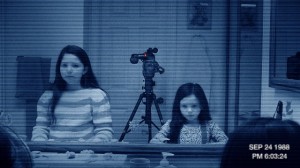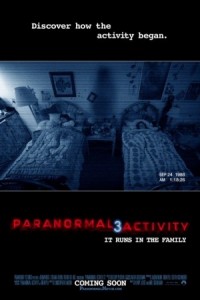Paranormal Activity 3 Review
November 6, 2011
By Nick Galasso
The Paranormal Activity series is one that has been met with a very split reaction amongst moviegoers. It’s a very “love-it-or-hate-it” type of series: You’re either going to think that it’s absolutely stupid and hokey, or you’re going to think that it’s a fine example of a good modern-day horror film. I fall into the latter category, I guess just due to the fact that ever since I saw Cloverfield back in 2008 I’ve taken a liking to the “found-footage” subgenre that’s emerged in the past few years. But that’s neither here nor there.
The fact is, I like the Paranormal Activity series. The first film is probably one of the better modern day horror films out there, giving us a good old-fashioned haunted house story on a very small scale; the second film, while an inferior movie, keeps with the same consistent tone as the first, proving to be a worthy successor – a rarity for most horror sequels. But the details regarding my feelings towards those two movies are for another time. My focus of this article is the third film, so let’s jump right in!
And just as a warning, be prepared for spoilers from this point on …
The third entry in the Paranormal Activity series proves to be another worthy successor, providing us with effective scares and some spine-tingling suspense, keeping in tone with that “good old-fashioned haunted house story” that I mentioned before. However, it would definitely be with this film that I would end the series (which most likely will not be happening), as it’s with this film that the series does start to show signs of an almost guaranteed rapid decline. And I mean, can you honestly blame the series? The majority of these films rely on their scares, and to be honest, there’s only so many different ways you could provide a scare in a found-footage haunted house story. However, the film still manages to put to good use whatever the series has left in it.
For one thing, if you haven’t seen any of the first two films, watch them before you see this. While you will be able to understand the main plot-line just fine if you haven’t seen either of the first two films, there’s plenty of back story explained in the first two movies that you should also be aware of before going into this one. The film is essentially a flashback – it opens with Katie, one of the protagonists of the first film, visiting her sister, Kristi, one of the protagonists of the second film. Katie delivers a box of old video tapes to Kristi. These same video tapes wound up being stolen a year later, something that was already revealed at the beginning of the second film, thus providing the major link among all three films in the series.
We then move on to the content of the video tapes themselves, although the source of who is supposed to be playing these videos is unknown. We see a young Katie and Kristi living with their mother, Julie, and her boyfriend, Dennis, who provides us with the camera footage seen throughout the film. During one of Dennis’ … ahem … episodes he films with the camera, an earthquake occurs and as he reviews the footage, he notices that dust falling from the ceiling lands on an invisible figure. Suspecting a ghost, he decides to set up cameras throughout the house, with the cameras he places in his own room, Katie and Kristi’s room, and the kitchen detailing much of the action for us.
And it’s at this point where my major problems with the film begin to occur. For the majority of the film’s first act, it constantly goes back and forth between effective scares and then recycled horror plot lines and cheap scare tactics. One of the cameras that Dennis sets up catches the action in both his kitchen and living room, which connect to each other. He only uses one camera to get both rooms, and he does so by dismantling a rotating fan and replacing it with the camera, allowing for it to move back and forth between the two rooms. While this allows for some very nicely done slow burn sequences that provide some great moments of suspense, there are also a fair amount of cheap jump scares that occur just as the camera fully faces either of the two rooms.

Meanwhile, in the sister’s room, we find out that Kristi gets up in the middle of the night on a regular basis to talk to her supposed imaginary friend, Toby, who supposedly is behind a lot of her actions throughout the film. This is a common plot element for horror films, most notably used in The Shining. With the amount of times this plot device has been used, by this point it now feels hokey, contrived, and forced, and it goes against the way in which the characters interacted with the ghostly presences in the previous two movies. While in both the first and second film, the ghosts simply possessed the female leads in order to get them to do what they wished, here we have scenes of a ghost – who for all we know is one of the same ghosts from the first two movies – trying to bargain and reason with a little girl in order for her to do its will. I guess at this point in the series’ history, the ghost has yet to graduate from the Academy of How to Properly Haunt a House. Although, hey, we all have to start somewhere, am I right?
The film jarringly goes back and forth between actual scares and phony moments like the aforementioned one for about a good forty-five minutes or so. As we make our way into the second act of the film, the film downplays most of these phony moments and focuses more on what the series is all about: Scaring the bejeezus out of you! The turning point comes in the form of an alternate, extended version of the “Bloody Mary” sequence that was oh so heavily advertised in the film’s trailers. This proves to be one of the best sequences in the film, sending constant waves of terror that keep you constantly alert for what’s to come next. This is the kind of tone that the film takes on for its entire second half, effectively pulling itself out of the jarring slump displayed in the inferior first half. The scares are top-notch, guided by some impressive camera work as well as the decision to rarely give the audience a rest to recover from a previous suspenseful moment, although never getting to the point of being loud or obnoxious with said decision.
The only problem one may have with the second half would be the finale, which harkens back to the typical ending of a found-footage film. Now if you know your found-footage films well enough, I don’t even need to explain the ending, as just about all of them contain roughly the same type of ending, and this is no different. The ending, like in all other found-footage films, will heavily add to your reaction of the film, as it is one of the main causes of the divisive reactions towards found-footage films. You’re either going to dismiss it as phony and base most of your hatred of the film on it, or you’re simply just going to accept it for what it is and come out of the film enjoying it as a whole. Once again, I fall into the latter category.


